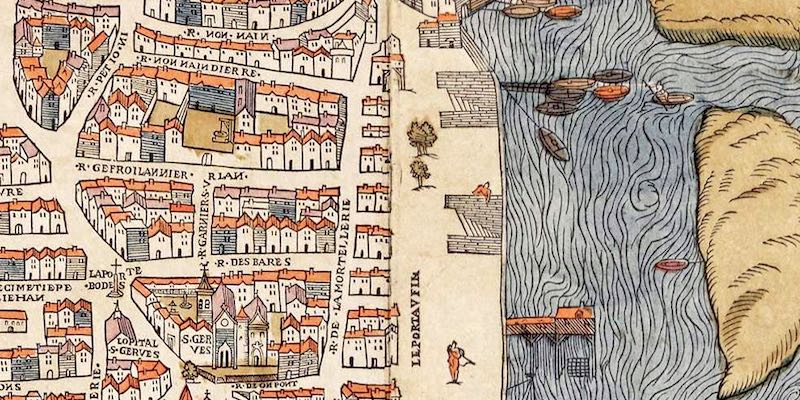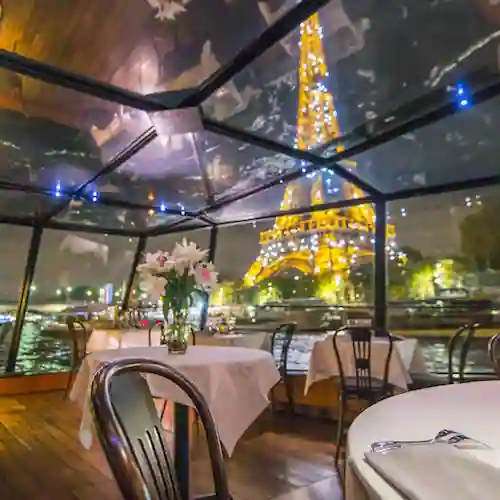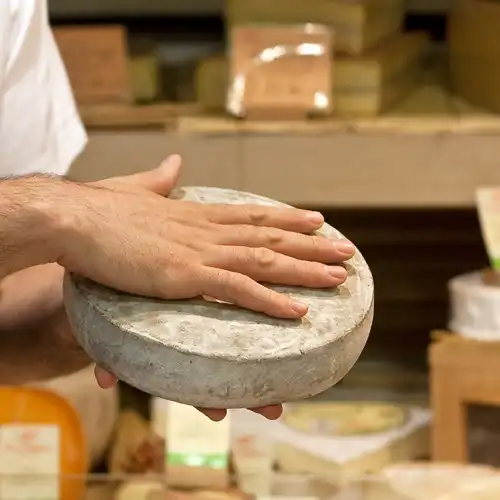The Paris Explorer – Rue des Barres In The Marais
Even in the City of Light there are places that may be a little bit in the shadows — places you may not have heard about, places you have to search to find. Seeking out these places can deliver a little thrill of pleasure; you feel like an explorer finding the unexpected in a city we think we know so well. As part of our series called The Paris Explorer let's virtually visit Rue des Barres, in the Marais.
![]()
Discover What's On When You're Here...
• January... |
• February... |
• March... |
• April... |
• May... |
• June... |
• July... |
• August... |
• September... |
• October... |
• November... |
• December... |
Discover What's On When You're Here
• January...
|
• February... |
• March... |
|---|---|---|
• April... |
• May... |
• June... |
• July... |
• August... |
• September... |
• October... |
• November... |
• December... |
Rue des Barres – An Ancient Street in Paris
 Map of Paris from 1550 showing Rue des Barres. North is to the left.
Map of Paris from 1550 showing Rue des Barres. North is to the left.
Rue des Barres is a short street (150 yards) with a long history. In medieval Paris there were water-powered mills on the banks of the Seine; one of them was name Moulin des Barres, most likely after a defensive barrier that once had been located on that site. (Barriers, or barres, were found along the river back then. Viking invaders and all that.) The street that came off the Seine was naturally called Rue des Barres.
Rue des Barres appears on one of the earliest detailed maps of Paris (as R. des Bares) from 1550 that shows it running between Rue de La Mortellerie (today's Rue de l'Hôtel de Ville) and La Porte Bodes (Rue François Miron). Unusually, north is to the left on the map. In the Seine you can see the two islands that were later joined together to form Île Saint-Louis in 1614 . You can also see the Moulin des Barres on the Seine.
![]()
|
Paris Dinner Cruises on the Seine Dine in style as you glide past the Eiffel Tower, Notre-Dame, and the Louvre on a magical Seine River cruise. Gourmet food, champagne, and Paris lit up at night – it’s unforgettable. |
|
Paris Dinner Cruises on the Seine Dine in style as you glide past the Eiffel Tower, Notre-Dame, and the Louvre on a magical Seine River cruise. Gourmet food, champagne, and Paris lit up at night – it’s unforgettable. |
![]()
In 1250, a mansion was built on Rue des Barres called, unsurprisingly, Hôtel des Barres. 150 years later the hôtel was purchased by Louis de Boisredon, the captain of the Queen's Bodyguards who. As a handsome man in uniform, Louis also became Queen Isabeau's lover. One day in April 1417, Louis happened to pass by king Charles VI on the street and merely gave him a small salute, without bothering to dismount to properly honor his sovereign.
Whether it was because of that slight or because of the hanky-panky with the queen, Charles had Louis arrested, sewn up in a bag, and thrown into the Seine. On the bag was written, "Laissez passer la justice du Roi". (Something like "Let the justice of the King pass".)
![]()
|
Trade Paris bustle for royal grandeur on a guided Versailles tour. Skip the lines, wander the gardens, and peek inside Marie Antoinette’s private estate. History never looked this good. |
|
Trade Paris bustle for royal grandeur on a guided Versailles tour. Skip the lines, wander the gardens, and peek inside Marie Antoinette’s private estate. History never looked this good. |
Historic Buildings of Rue des Barres
 Rue des Barres as it looks today. Photo Wikimedia Commons by mbz.t
Rue des Barres as it looks today. Photo Wikimedia Commons by mbz.t
We don't know if the incident with the king happened on Rue des Barres, but we like to imagine it did every time we walk along this pedestrian passageway that runs almost from the Seine, at Pont Louis-Philippe, up to Rue François Miron in the Marais. At the lower end (the Seine end) Rue des Barres begins next to restaurant Café Louis Philippe (with its lovely terrace) and is tucked behind a tall period building that houses another restaurant, Chez Julien, from where the street climbs a series of wide shallow steps on its way into the Marais.
As you climb the steps, on your left is Église Saint-Gervais-et-Saint-Protais. There's been a church here since the 7th century (you can spot the church on the 1550 map, labelled S.Gerves); the current one was built over a 150-year period ending in about 1650. Step inside to see the dramatic stained glass and the ceiling of the nave. There was tragedy here — during Good Friday service in 1918 a German artillery shell landed on the church, killing 88 people and wounding dozens more.
![]()
|
Skip the long lines and dive into the Louvre’s greatest hits — the Mona Lisa, Venus de Milo, and more — on a guided tour that shows you the treasures without the museum overload. |
|
Skip the long lines and dive into the Louvre’s greatest hits — the Mona Lisa, Venus de Milo, and more — on a guided tour that shows you the treasures without the museum overload. |
![]()
 House at 15 Rue des Barres, built in 1624. Photo Wikimedia Commons by mbzt.
House at 15 Rue des Barres, built in 1624. Photo Wikimedia Commons by mbzt.
![]()
Further along the street you can spot some historic buildings. Number 12 dates from the time there was an abbey here; this was the home of the nuns, rebuilt in 1540 in the half-timbered style (called maison à colombages). At number 15 is a house that dates from 1624.
Before you leave the quartier wander down to the riverbank to relax a while in the Parc Rives de Seine, now completely traffic free.
Paris Planning Guides
 Book an Airport Transfer
Book an Airport Transfer |
 Left Bank Hotels
Left Bank Hotels |
 Visiting Versailles
Visiting Versailles |
 Glorious Dinner Cruises
Glorious Dinner Cruises |
















